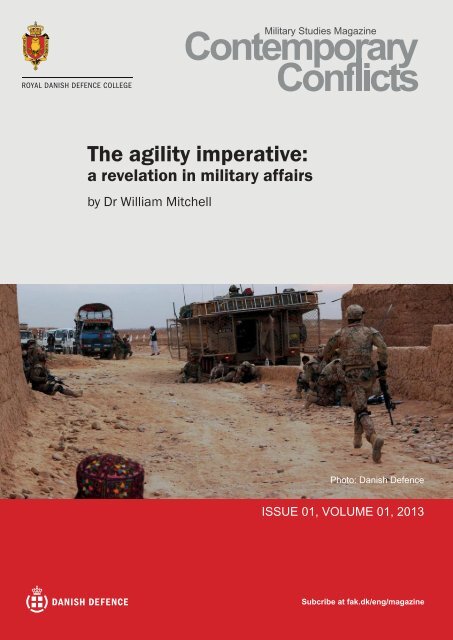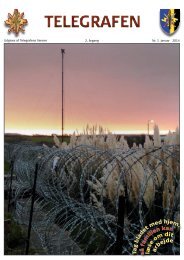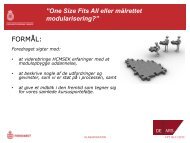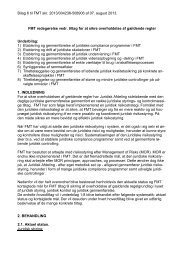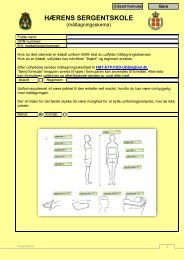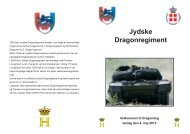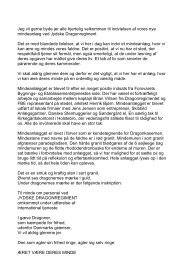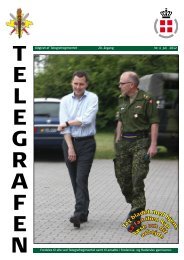The agility imperative - a revelation in military affairs.indd
The agility imperative - a revelation in military affairs.indd
The agility imperative - a revelation in military affairs.indd
Create successful ePaper yourself
Turn your PDF publications into a flip-book with our unique Google optimized e-Paper software.
Military Studies Magaz<strong>in</strong>e<br />
<strong>The</strong> <strong>agility</strong> <strong>imperative</strong>:<br />
a <strong>revelation</strong> <strong>in</strong> <strong>military</strong> <strong>affairs</strong><br />
by Dr William Mitchell<br />
Photo: Danish Defence<br />
ISSUE 01, VOLUME 01, 2013<br />
1<br />
Subcribe at fak.dk/eng/magaz<strong>in</strong>e
<strong>The</strong> <strong>agility</strong> <strong>imperative</strong>: a <strong>revelation</strong> <strong>in</strong> <strong>military</strong> <strong>affairs</strong><br />
War fi ght<strong>in</strong>g <strong>in</strong> the 21 st century and the <strong>in</strong>formation age is more about the speed of learn<strong>in</strong>g than it is about the<br />
speed of reload<strong>in</strong>g. Granted, this simplistic understand<strong>in</strong>g of modern warfare is entic<strong>in</strong>gly suggestive <strong>in</strong> that<br />
it appears to focus on someth<strong>in</strong>g more than just destruction. <strong>The</strong> notion that the number of tanks or warships<br />
you have matters less than your ability to th<strong>in</strong>k network rather than l<strong>in</strong>early is comfort<strong>in</strong>g. But gone is also<br />
the physical certa<strong>in</strong>ty of w<strong>in</strong>n<strong>in</strong>g or los<strong>in</strong>g decisive battles and formal surrenders of state actors. <strong>The</strong> security<br />
environment is driven by an unparalleled explosion <strong>in</strong> <strong>in</strong>formation transfer that has affected how humans fundamentally<br />
organise and develop ideas. <strong>The</strong> <strong>military</strong> cannot avoid the impact of these developments and the<br />
challenges they present. By the end of 2013 the <strong>agility</strong> <strong>imperative</strong> will likely stand out as one of the defi n<strong>in</strong>g<br />
characteristics necessary for <strong>military</strong> organisations to fi ght wars <strong>in</strong> the 21 st century.<br />
By Dr William Mitchell<br />
<strong>The</strong> <strong>military</strong> legacy of learn<strong>in</strong>g – or not<br />
Military history is full of moments where <strong>military</strong> organisations learned the hard way that ma<strong>in</strong>ta<strong>in</strong><strong>in</strong>g organisations,<br />
technologies and doctr<strong>in</strong>e for war fight<strong>in</strong>g based on tradition and rout<strong>in</strong>e rather than environment can<br />
have terrible consequences. Few to none of these have been celebrated as victors or heroes, most pitied as the<br />
unfortunate victims of modernisation. And like other significant times <strong>in</strong> <strong>military</strong> history driven by technological<br />
breakthroughs, there is a period of transition with<strong>in</strong> both the physical and cognitive dimensions of the<br />
war fight<strong>in</strong>g environment. From the spear to the armed unmanned aerial vehicle (UAV), from the romantic<br />
idealism of chivalry to the legal rationality of the Law of Armed Conflicts, the environment <strong>in</strong> which we fight<br />
is constantly evolv<strong>in</strong>g and always has. However, the <strong>in</strong>formation age is more than a physical attribute of the<br />
modern war fight<strong>in</strong>g environment; its impact is on the dynamic of change itself. <strong>The</strong>re is no doubt that the<br />
onset of the <strong>in</strong>formation age has affected every aspect of human life: how we th<strong>in</strong>k, how we manage <strong>in</strong>formation,<br />
how we use the <strong>in</strong>formation, how we communicate with each other. It has also set <strong>in</strong> motion a pace<br />
of learn<strong>in</strong>g, development and change that is perpetually accelerat<strong>in</strong>g. <strong>The</strong> faster we learn from each other, the<br />
faster we adapt, <strong>in</strong>novate, develop and respond. We are exploit<strong>in</strong>g knowledge faster and over greater distances<br />
than at any other po<strong>in</strong>t <strong>in</strong> history.<br />
<strong>The</strong> context of <strong>military</strong> operations is not a separate universe from the one all humans are expected to operate<br />
<strong>in</strong>. It is this environment of <strong>in</strong>formation hyper drive that the 20 th -century <strong>military</strong> has found itself struggl<strong>in</strong>g to<br />
adapt to. Struggl<strong>in</strong>g with reta<strong>in</strong><strong>in</strong>g, discover<strong>in</strong>g and recreat<strong>in</strong>g its own identity and history. Struggl<strong>in</strong>g to fit a<br />
fast chang<strong>in</strong>g world that only a short 30 years ago was still slow enough to provide a rock solid raison d’étre<br />
for cont<strong>in</strong>u<strong>in</strong>g the way the <strong>military</strong> has generally organised itself s<strong>in</strong>ce the time of Napoleon.<br />
Military history is full of significant leaps forward <strong>in</strong> <strong>military</strong> organisation, doctr<strong>in</strong>e and technology. Examples<br />
are many: the <strong>in</strong>vention and employment of chariots, flex bows, longbows, gunpowder, cannons and, more<br />
recently, mach<strong>in</strong>e guns, aircraft, the tank by the British, its effective use by the Germans. <strong>The</strong>re are many.<br />
2
However, despite be<strong>in</strong>g significant leaps, sometimes heralded as revolutions <strong>in</strong> <strong>military</strong> <strong>affairs</strong> (RMAs), they<br />
have all had limited periods of dom<strong>in</strong>at<strong>in</strong>g success, ma<strong>in</strong>ly because human opponents do what human opponents<br />
do best when faced with annihilation – learn quickly how to survive.<br />
<strong>The</strong> <strong>agility</strong> <strong>imperative</strong>: a <strong>revelation</strong> <strong>in</strong> <strong>military</strong> <strong>affairs</strong><br />
But this time the change is different. This time it is not a technological development <strong>in</strong> itself or a new way<br />
of us<strong>in</strong>g technology <strong>in</strong> terms of doctr<strong>in</strong>e or organisation provid<strong>in</strong>g the fortunate commander complete battlespace<br />
dom<strong>in</strong>ation. This time it is a much deeper and fundamental change. This time it does not resemble a<br />
revolution <strong>in</strong> <strong>military</strong> <strong>affairs</strong> as much as it resembles a <strong>revelation</strong>.<br />
<strong>The</strong> war fighter may not like to use the word ‘ontology’, but war fight<strong>in</strong>g organisations are already plann<strong>in</strong>g<br />
and fight<strong>in</strong>g ontologically. For those not familiar with the word ontology, it simply refers to the study of categories<br />
of realities. Today’s <strong>military</strong> is work<strong>in</strong>g operationally with two ‘reality’ categories of ontology, the<br />
cognitive and the physical. And though the cognitive reality consist<strong>in</strong>g of subjective beliefs, understand<strong>in</strong>gs,<br />
perceptions, identities and norms has always been there, the <strong>in</strong>formation age has significantly amplified its importance<br />
to <strong>military</strong> operations. As of 2013, the armies, navies, air forces and mar<strong>in</strong>es throughout the Alliance<br />
can be found discuss<strong>in</strong>g the merits of narrative lead operations, l<strong>in</strong>es of operations for social media and the<br />
importance of culture to situational understand<strong>in</strong>g. What must sound even more bizarre to some traditionalists<br />
are <strong>military</strong> discussions on the harmonisation and synchronisation of k<strong>in</strong>etics and non-k<strong>in</strong>etics for the destruction<br />
or construction of th<strong>in</strong>gs and/or ideas, understand<strong>in</strong>gs or narratives.<br />
Pragmatism and enlightenment<br />
Over the last five years the <strong>military</strong> has engaged the cognitive and physical realities of the battlespace through<br />
complex ‘system of systems analysis’ known (somewhat lov<strong>in</strong>gly) to some as SoSA. <strong>The</strong>se networked-def<strong>in</strong>ed<br />
understand<strong>in</strong>gs of battlespaces such as ‘PMESII’, represent<strong>in</strong>g the <strong>in</strong>teraction between the Political, Military,<br />
Economic, Social, Infrastructure and Information doma<strong>in</strong>s of a battlespace, attempt to del<strong>in</strong>eate and describe<br />
and synthesise the two realities of the battlespace. This understand<strong>in</strong>g is then comb<strong>in</strong>ed with an effects-based<br />
th<strong>in</strong>k<strong>in</strong>g (EBT) philosophy that attempts to manage the <strong>in</strong>teraction between the PMESII doma<strong>in</strong>s or, if you<br />
wish, between the two realities, the cognitive and the physical. Light-heartedly translated as ‘blow someth<strong>in</strong>g<br />
up at the right time and place to create a perception – or if you wish – at the right time and place destroy a<br />
perception by not blow<strong>in</strong>g someth<strong>in</strong>g up’.<br />
And despite the echoes of ‘common sense’ r<strong>in</strong>g<strong>in</strong>g somewhere <strong>in</strong> the background of this perpetual <strong>in</strong>teraction<br />
between the cognitive and the physical dimensions, from a scientific perspective it is a complex ontological<br />
relationship between two categories of realities. Now, imag<strong>in</strong>e what the Internet or social media has done to<br />
3
the speed of those <strong>in</strong>teractions, and you will understand how the speed of learn<strong>in</strong>g and adaptation <strong>in</strong> the battlespace<br />
itself has taken a quantum leap.<br />
So the <strong>military</strong> has realised that its battlespace is a nexus – a sort of smelt<strong>in</strong>g pot – for net sum <strong>in</strong>teractions<br />
of the physical and cognitive realities of the battlespace. <strong>The</strong> adage ‘actions speak louder than words’ is not<br />
really a cry for k<strong>in</strong>etics but rather a cry for physical confirmation of a socially def<strong>in</strong>ed cognitive understand<strong>in</strong>g.<br />
If you do it – you must mean it. So what are the key characteristics of a 21 st -century battlespace <strong>in</strong> my view?<br />
1. Actions <strong>in</strong> modern warfare acquire mean<strong>in</strong>gs and understand<strong>in</strong>gs, while mean<strong>in</strong>gs and understand<strong>in</strong>gs<br />
require actions <strong>in</strong> modern warfare.<br />
In this regard the <strong>in</strong>formation age has expanded and speeded up the ‘mean<strong>in</strong>gs and understand<strong>in</strong>gs’<br />
part beyond anyth<strong>in</strong>g seen before <strong>in</strong> history. Roughly stated it is not just what you blow up that is important;<br />
it is its effect on the systems of systems context surround<strong>in</strong>g the why, how, when, where that<br />
determ<strong>in</strong>es the end value of the k<strong>in</strong>etic action. <strong>The</strong> action must be encased <strong>in</strong> the appropriate narrative<br />
perceived to be to your advantage. If not, though a certa<strong>in</strong> physical action <strong>in</strong> the battlespace might be<br />
desired from a <strong>military</strong> standpo<strong>in</strong>t, you might actually be shoot<strong>in</strong>g yourself <strong>in</strong> the foot politically, economically<br />
or socially with regard to perceptions of the action. <strong>The</strong> net worth of the action is therefore<br />
determ<strong>in</strong>ed by the sum of effects <strong>in</strong> both the physical and cognitive realities of the battlespace.<br />
2. <strong>The</strong> greater part of complexity and uncerta<strong>in</strong>ty <strong>in</strong> the modern battlespace comes from the <strong>in</strong>teraction<br />
of multiple subjective contexts <strong>in</strong> one time and space.<br />
Or stated another way, if all belligerent parties <strong>in</strong> the battlespace had the same culture, norms, values<br />
and narrative histories – manag<strong>in</strong>g warfare <strong>in</strong> the <strong>in</strong>formation age would still likely be a relatively<br />
straightforward test of physical strength.<br />
So, there it is. Note the absence of any discussion as to conventionality versus unconventionality. As <strong>in</strong>ferred<br />
earlier, this <strong>revelation</strong> is far deeper than compet<strong>in</strong>g (and somewhat determ<strong>in</strong>istic) taxonomies of doctr<strong>in</strong>e.<br />
As the chances of everyone suddenly enjoy<strong>in</strong>g each other’s company <strong>in</strong> a common constructed narrative of<br />
‘mank<strong>in</strong>d’ are not high for the foreseeable future, <strong>military</strong> efforts must focus on manag<strong>in</strong>g the challenges<br />
found <strong>in</strong> the first pr<strong>in</strong>ciple. It is based primarily on the need for speed and precision <strong>in</strong> knowledge development.<br />
It depicts a battlespace that is dynamic, subject to rapid transformations <strong>in</strong> time and space due to the<br />
speed of <strong>in</strong>formation flow. Action and perception can be as <strong>in</strong>stantaneous as the stream<strong>in</strong>g video or tweet<strong>in</strong>g<br />
technology <strong>in</strong> use on the day will allow. It depicts a battlespace that demands <strong>agility</strong>.<br />
Battlespace <strong>agility</strong><br />
‘Battlespace <strong>agility</strong>’ is a war fight<strong>in</strong>g concept that is simply def<strong>in</strong>ed as the speed at which the war fi ght<strong>in</strong>g<br />
organisation is able to transform knowledge <strong>in</strong>to actions for desired effects <strong>in</strong> a battlespace. It stems from a<br />
decade of NATO <strong>agility</strong> research and the application of conventional constructivist understand<strong>in</strong>gs <strong>in</strong> <strong>in</strong>telligence<br />
analysis and operational plann<strong>in</strong>g. At its very heart is the call for develop<strong>in</strong>g both the human and tech-<br />
4
nical capabilities to learn and exploit knowledge of the battlespace faster than an opponent, the objective be<strong>in</strong>g<br />
to outpace, deceive, disrupt and if possible destroy the enemy’s Observe, Orient, Decide and Act (OODA)<br />
loop. If you destroy their OODA loop, you have effectively destroyed their ability to manage the <strong>in</strong>teraction<br />
between the physical and the cognitive realities of the battlespace. When they take action, it will be perceived<br />
as the wrong one; when they decide on actions based on their perceptions, they will be based on the wrong<br />
understand<strong>in</strong>gs.<br />
As battlespace <strong>agility</strong> is itself a function of knowledge over time and space and <strong>in</strong> an age of split-second<br />
knowledge development, the onus of be<strong>in</strong>g agile starts with a competent <strong>military</strong> <strong>in</strong>telligence capacity cont<strong>in</strong>uously<br />
develop<strong>in</strong>g and present<strong>in</strong>g the commander with opportunities to exploit knowledge. It also requires a<br />
completely synthesised work<strong>in</strong>g relationship between operational planners and <strong>in</strong>telligence providers <strong>in</strong> order<br />
to be agile and responsive to the war fight<strong>in</strong>g environment. And this <strong>agility</strong> must be tra<strong>in</strong>ed so that the process<br />
of discovery and learn<strong>in</strong>g about the environment one f<strong>in</strong>ds oneself <strong>in</strong> (the Observe and Orient phases of<br />
OODA) is not lost through the constant hand feed<strong>in</strong>g of scenarios for validation of exist<strong>in</strong>g organisation and<br />
doctr<strong>in</strong>e. Battlespace <strong>agility</strong> requires that we stop try<strong>in</strong>g to make the situation fit exist<strong>in</strong>g organisation and doctr<strong>in</strong>e<br />
and focus on our ability to adapt the organisation and doctr<strong>in</strong>e to the situation. Instead we should focus<br />
on build<strong>in</strong>g a <strong>military</strong> <strong>in</strong>telligence organisation that can observe and orient complex war fight<strong>in</strong>g environments<br />
with good speed and precision. Instead we should tra<strong>in</strong> for the validation of the <strong>military</strong> organisation’s ability<br />
to observe, learn, adapt, <strong>in</strong>novate, respond, and change to exploit the situation. Agility is the <strong>imperative</strong> for<br />
war fight<strong>in</strong>g <strong>in</strong> the 21 st century, and tra<strong>in</strong><strong>in</strong>g to be agile is tra<strong>in</strong><strong>in</strong>g to fight and w<strong>in</strong>.<br />
Further read<strong>in</strong>g<br />
Alberts, D. (2011) <strong>The</strong> Agility Advantage. Wash<strong>in</strong>gton, DC: CCRP.<br />
Henrot<strong>in</strong>, J. & de Swielande, T. S. (2004) Ontological-Cultural Asymmetry and the Relevance of Grand<br />
Strategies. Journal of Military and Strategic Studies. 7 (2). 1-25.<br />
Libicki, M.C. and Johnson, S.E. (eds.) (1996) Dom<strong>in</strong>ant Battlespace Knowledge. April.<br />
Mann, P. (2001) Defence Reform Stresses Speed, Agility, Jo<strong>in</strong>tness. Aviation Week & Space Technology, 154 (25), 72.<br />
Mitchell, W. (2013) Battlespace Agility 201: <strong>The</strong> OODA Moment. Copenhagen: Royal Danish Defence College Press.<br />
NATO SAS-085, (Forthcom<strong>in</strong>g 2013) Operationaliz<strong>in</strong>g Agility.<br />
Rob<strong>in</strong>son, C.Jr. (2003) Military Marches Towards Agility. Signals Magaz<strong>in</strong>e. May.<br />
5


